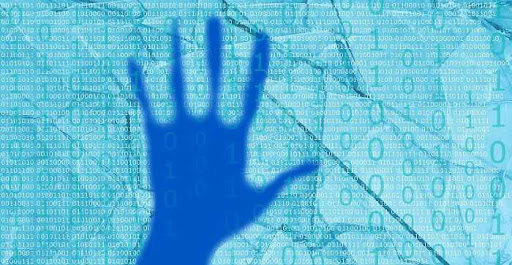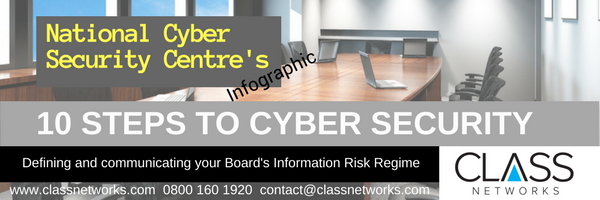As a business owner, you know that the internet is a vital part of your operations. Your customers expect to be able to discover your services online, and you need to be able to access your files from anywhere in the world. This means that it’s more important than ever to make sure your business is safe from the unscrupulous efforts of cyber criminals. In this blog post, we will discuss 10 steps that you can take to improve your cyber security posture and keep your business safe online!
The National Cyber Security Centre has published lots of informative information about this. View the NCSC 10 steps to cyber security infographic for more information.
As an accredited Architect for Sophos Unified Threat Management (UTM) Cyber security products, we’re perfectly placed to assume responsibility for all of your cyber security requirements, safeguarding all potential access points to your data and applications, from the physical to the virtual.
Call Class Networks today on 0333 800 8822 to find out more about our multi-layered security solutions for your business or non profit organisaiton.

What is cyber security?
An organisation’s cyber security is the key to its success.
Cyber security is the practice of protecting your computer systems and networks and user data from unauthorised access or theft. Common cyber threats include things like installing antivirus software, using firewalls, and encrypting your data. By taking these precautions, you can help protect yourself against cyber attacks.
Cybercrime is costing the world economy more than £450 billion each year, according to a 2020 study carried out by McAfee and the CSIS (Centre for Strategic and International Studies), based on data collected by Vanson Bourne. This figure is projected to grow to £600 billion by 2025.
One recent example of a cyber attack was the WannaCry ransomware attack, which affected hundreds of thousands of computers in over 150 countries. This attack used a malware program to encrypt users’ data and then demand a ransom payment in order to unlock it.
Cyber attacks are also becoming more sophisticated and widespread, with a new attack happening every 39 seconds – that’s around two million attacks per year.

Common types of cyber attacks
- Malware
- Phishing
- Man-in-the-Middle (MitM) attacks
- Distributed Denial-of-Service (DDOS) attack
- SQL Injections
- Zero-day Exploit
- Password Attack
- Cross-site Scripting
- Rootkits
- Internet of Things (IoT) attacks
What are the 10 steps to improve cyber security:
1. Set up your Risk management Regime
Cyber security is a complex and ever-evolving field, and it’s important to have a solid risk management regime in place to protect your business. This includes things like assessing your cyber security risks, putting in place contingency plans, and training your employees on how to stay safe online. The risk management process is the cycle of identifying, analysing and evaluating risks. It may also include prioritising them based on their potential impact on the project and determining responses you will take should they occur.
2. Managing user privileges
There are many different factors to consider when it comes to identity and access management (IAM). The first step is understanding who or what needs access, and under what conditions. This includes specifying the roles and responsibilities of each user, as well as defining the systems and data that they need access to. You also need to decide on an authentication mechanism and choose appropriate methods to establish and prove the identity of users, devices or systems.
This information can then be used as part of an access control mechanism. Access controls ensure that only authorised users are allowed to access a system or service and that they have the level of access required for their role without exceeding these permissions. There are many different types of access control, but the most common are role-based access controls (RBAC) and discretionary access controls (DAC).
3. Incident management
The financial impact of an incident can be significant, with organisations losing money through downtime, loss of productivity and damage to their reputation. General data protection regulation (GDPR) breaches can also be highly detrimental. It is therefore important that companies have a good incident management plan in place. This will help them to detect and respond quickly to any incidents, preventing further damage and reducing the overall impact on the organisation. Managing an incident in the public eye can be difficult, but by following a set of appropriate procedures and using specialist support, the impact on the company’s reputation can be minimised.
After an incident has occurred, it is important to review what happened and learn from any mistakes made. This will help to improve your organisation’s ability to deal with future incidents, reducing the chances of them having a financial or operational impact.
4. Monitoring
Developing a monitoring strategy and supporting policies is an important step in protecting your organisation from cyberattacks. By continuously monitoring all systems and networks, you can identify any suspicious activity that could indicate an attack. And by having a plan in place for when an attack does occur, you can mitigate the damage and restore normal operations.
It’s also important to have a plan in place for when an attack does occur. The plan should include steps for identifying the extent of the breach, containing the damage, and restoring normal operations.
5. Home and mobile working
More and more businesses are using mobile devices to conduct their operations. This trend presents both opportunities and challenges for organisations. On the one hand, employees who use mobile devices are more productive than those who do not. On the other hand, using a mobile device comes with risks. The risk can be minimised by implementing physical and logical controls to ensure that the organisation’s data is safe and secure. The policy should spell out which devices are authorised for use and what type of data can be accessed on them.
6. Secure configuration
One of the most effective ways to protect your organisation’s data is to ensure that all systems are securely configured. This includes ensuring that all devices have up-to-date security patches and using strong passwords. You should also define a baseline build for all devices, which can be used as a reference point for future configurations.
In order to maintain the secure configuration of all systems, it is important to create a system inventory. This will help you to track the devices in your organisation and ensure that they are all configured according to your security policy.
7. Removable media controls
Media controls can be used to prevent the loss or theft of sensitive data. The policy should define which types of media are approved for use and what type of data is allowed on them. It should also outline procedures for handling removable media, such as encrypting it when not in use or storing it in a locked cabinet.
Removable media controls can also be used to prevent the spread of malware. By scanning all media for malware before importing it onto the corporate system, you can help protect your organisation from infection.
8. Malware prevention
Malware prevention is one of the most important aspects of cybersecurity. Without effective prevention measures, it is possible for cybercriminals to attack your organisation’s systems and steal data or cause disruption. As such, all organisations should have a policy in place that outlines their approach to preventing malware attacks.
One of the best ways to prevent malware attacks is to use a strong antivirus solution. The policy should specify which AV products are approved for use and how they should be configured. It is also important to keep all software up-to-date, including the operating system and applications.
9. User education and awareness
Your security policies should cover acceptable and secure use of your systems by employees. They should also be included in staff training so that everyone is aware of the cyber risks associated with their job function. You need to maintain an ongoing awareness of these risks and take steps to protect your organisation from them.
Cyber security training platforms such as Bullphish ID provide regular, evolving security and phishing awareness training for staff in bite size modules which help to raise awareness of potential threats, minimising the risk of human error.
10. Network Security measures
Network security is essential to ensure that all devices connected to your network are configured correctly and only allow access to authorised users. The policy should specify which types of devices are approved for use on the network and how they should be configured. It is also important to define procedures for handling unauthorised devices, such as disconnecting them from the network or reporting them to security staff.
Network security should also include measures to protect your organisation from malicious content. This can be done by using a firewall to block traffic from unauthorised sources and installing intrusion detection systems (IDS) to detect suspicious activity.
Stay secure with Class Networks
Class Networks is the trusted choice when it comes to keeping your business safe online. Contact us today to learn more about how we can help you keep your business safe online. We offer a variety of services to suit your needs, from baseline builds for all devices, to malware prevention and user education and awareness.

Posted in Resources
